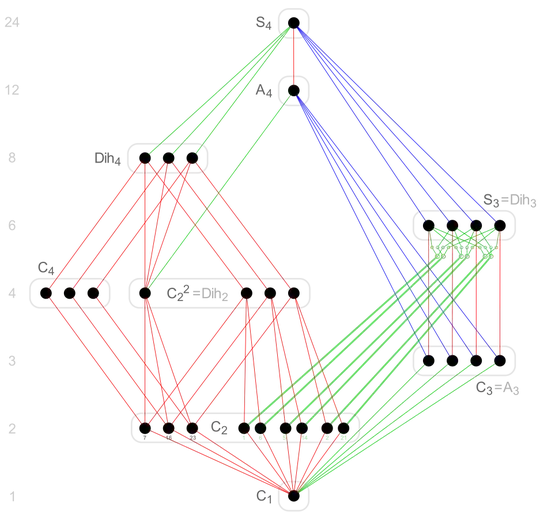For any given $n$, this can be done using Möbius inversion on the lattice of subgroups of $S_n$. For an introduction to Möbius inversion, see e.g. Section $5.2$ of Martin Aigner's A Course in Enumeration. In a nutshell, it's a generalized form of the inclusion–exclusion principle.
I'll work it out for $S_3$ and $S_4$; I don't know of a systematic way of doing it for general $n$.
The subgroup structure of $S_3$ is described here, including this somewhat Enterprise-esque diagram:

Let's denote the subgroups by $S_3$, $A_3$, $T_1$, $T_2$, $T_3$ and $I$ (from top to bottom and from left to right). Using the superset relation $\supseteq$ as the partial order $\le$, we can find the required values of the Möbius function using Aigner's Proposition $5.4$:
$$\mu(a,a)=1\;,$$
$$
\mu(a,b)=-\sum_{a\le z\lt b}\mu(a,z)\;,
$$
and thus
\begin{eqnarray*}
\mu(S_3,S_3)&=&1\;,\\
\mu(S_3,A_3)&=&-1\;,\\
\mu(S_3,T_i)&=&-1\;,\\
\mu(S_3,I)&=&3\;.
\end{eqnarray*}
If we denote the probability for the subgroup generated by $m$ random elements to be contained in $H$ by $f_m(H)$ and the probability for that subgroup to be exactly $H$ by $g_m(H)$, then
$$
f_m(H)=\sum_{K\subseteq H}g_m(K)\;,
$$
so we can use Möbius inversion from above (Aigner's Theorem $5.5$ (ii)) to obtain
$$
g_m(H)=\sum_{K\subseteq H}\mu(H,K)f_m(K)
$$
and thus in particular
$$
g_m(S_3)=\sum_{K\subseteq S_3}\mu(S_3,K)f_m(K)\;.
$$
With
$$f_m(K)=\left(\frac{|K|}{|S_3|}\right)^m\;,$$
this becomes
$$g_m(S_3)=1-2^{-m}-3\cdot3^{-m}+3\cdot6^{-m}\;.$$
We can check this against a direct calculation for $m=2$, where we have to draw either a transposition and a $3$-cycle or two different transpositions to generate all of $S_3$, with probability
$$
2\cdot\frac36\cdot\frac26+\frac36\cdot\frac26=\frac12\;,
$$
and indeed
$$g_2(S_3)=1-2^{-2}-3\cdot3^{-2}+3\cdot6^{-2}=\frac12\;.$$
The subgroup structure of $S_4$ is analyzed here, including this amazing diagram:

(Attribution for the diagram: By Watchduck (a.k.a. Tilman Piesk) - Own work, CC BY-SA 4.0, Link).
Using the diagram's labels for the types of subgroups (but with $D_4$ instead of $\text{Dih}_4$) and distinguishing the left-hand and right-hand types of $C_2^2$ and $C_2$ groups in the diagram by $L$ and $R$, respectively, we find as above:
\begin{eqnarray*}
\mu(S_4,S_4)&=&1\;,\\
\mu(S_4,A_4)&=&-1\;,\\
\mu(S_4,D_4)&=&-1\;,\\
\mu(S_4,S_3)&=&-1\;,\\
\mu(S_4,C_4)&=&0\;,\\
\mu(S_4,C_2^{2L})&=&3\;,\\
\mu(S_4,C_2^{2R})&=&0\;,\\
\mu(S_4,C_3)&=&1\;,\\
\mu(S_4,C_2^L)&=&0\;,\\
\mu(S_4,C_2^R)&=&2\;,\\
\mu(S_4,C_1)&=&-12\;.\\
\end{eqnarray*}
Then Möbius inversion from above yields
$$
g_m(S_4)=1-2^{-m}-3\cdot3^{-m}-4\cdot4^{-m}+3\cdot6^{-m}+4\cdot8^{-m}+12\cdot12^{-m}-12\cdot24^{-m}\;.
$$
Again we can check the case $m=2$ by hand. The following pairs of elements of $S_4$ generate all of $S_4$: each one of $6$ transpositions with one of $4$ $3$-cycles or with one of $4$ $4$-cycles, each one of $8$ $3$-cycles with any one of $6$ $4$-cycles, and each one of $6$ $4$-cycles with one of $4$ $4$-cycles, for a probability of
$$
\frac{2\cdot6\cdot4+2\cdot6\cdot4+2\cdot8\cdot6+6\cdot4}{24^2}=\frac38\;,
$$
and indeed
$$
g_2(S_4)=1-2^{-2}-3\cdot3^{-2}-4\cdot4^{-2}+3\cdot6^{-2}+4\cdot8^{-2}+12\cdot12^{-2}-12\cdot24^{-2}=\frac38\;.
$$
For $m\to\infty$, the leading term will always be the one corresponding to $A_n$, so the probability not to generate all of $S_n$ is asymptotic to $2^{-m}$ for all $n$.
For $m=2$, the problem has been extensively studied; see Probability that two randomly chosen permutations will generate $S_n$. The main result quoted there is the following asymptotic series from John Dixon's paper Asymptotics of generating the symmetric and alternating groups:
$$t_n\sim1-\frac1n-\frac1{n^2}-\frac4{n^3}-\frac{23}{n^4}-\frac{171}{n^5}-\frac{1542}{n^6}+O\left(\frac1{n^7}\right)\;.$$
The numerators form OEIS A113869. This series applies to both the probability that two uniformly randomly chosen elements of $A_n$ generate $A_n$ and the probability that two uniformly randomly chosen elements of $S_n$ generate either $A_n$ or $S_n$; it follows that
$$
g_2(S_n)\sim\frac34t_n\;.
$$
The last section of this paper also contains a generalization of this asymptotic series for $m\gt2$.

